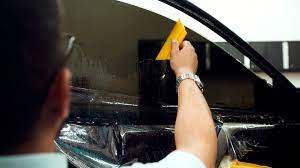
Window tinting has become increasingly popular among vehicle owners and homeowners alike. Beyond its aesthetic appeal, solar control window tinting offers a multitude of benefits, ranging from increased privacy to protection against harmful UV rays. In this comprehensive guide, we delve into the world of window tinting, exploring its benefits, different types, and the installation process.
Benefits of Window Tinting:
- UV Protection: One of the primary benefits of window tinting is its ability to block harmful UV rays. This not only protects occupants from sunburn but also helps prevent interior fading and damage to upholstery and furnishings.
- Heat Reduction: Window tinting can significantly reduce the amount of heat entering a vehicle or building, creating a more comfortable environment and reducing the need for excessive air conditioning.
- Glare Reduction: Tinted windows reduce glare from the sun and headlights, enhancing visibility and reducing eye strain while driving or working indoors.
- Privacy and Security: Tinted windows provide increased privacy by limiting the visibility of the interior from the outside. This can deter potential burglars and enhance the security of both vehicles and buildings.
- Energy Efficiency: By reducing heat gain, window tinting can contribute to lower energy bills, particularly in hot climates where air conditioning usage is high.
Types of Window Tinting:
- Dyed Film: Dyed window tinting is the most affordable option and provides basic UV protection and glare reduction. However, it may fade over time and is less effective at heat reduction compared to other types.
- Metalized Film: Metalized window tinting contains tiny metallic particles that reflect heat and UV rays. While more durable than dyed film, it can interfere with electronic signals and may have a reflective appearance.
- Carbon Film: Carbon window tinting offers superior heat reduction and UV protection without interfering with electronic signals. It also provides a sleek, non-reflective finish and is highly durable.
- Ceramic Film: Ceramic window tinting is the premium option, featuring advanced technology that blocks heat and UV rays while maintaining optimal visibility. It is highly resistant to fading and offers the best clarity and color stability.
Installation Process:
Window tinting should always be performed by a professional to ensure proper application and adherence to local regulations. The process typically involves the following steps:
- Cleaning: The windows are thoroughly cleaned to remove any dirt, dust, or debris that could interfere with the tinting process.
- Cutting: The tinting film is precisely cut to fit the dimensions of each window, ensuring a seamless and professional-looking installation.
- Application: The tinting film is carefully applied to the interior surface of the windows using a solution to prevent bubbles and ensure smooth adhesion.
- Drying: The tinting film is allowed to dry completely, typically taking 1-2 days, depending on the type of film and environmental conditions.
- Inspection: Once dry, the windows are inspected for any imperfections or bubbles, which are then addressed by the installer.
Conclusion:
Window tinting offers a range of benefits, from improved privacy and security to enhanced comfort and energy efficiency. By understanding the different types of window tinting and the installation process, consumers can make informed decisions to enjoy the advantages of tinted windows in their vehicles and homes. Whether seeking relief from the sun’s glare or protecting against UV radiation, window tinting provides a practical and stylish solution for any environment.